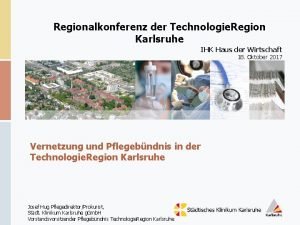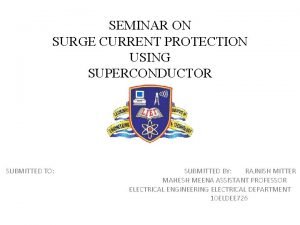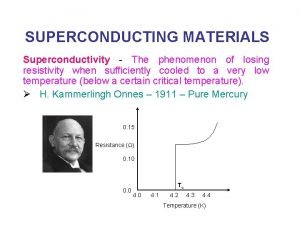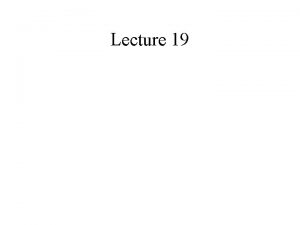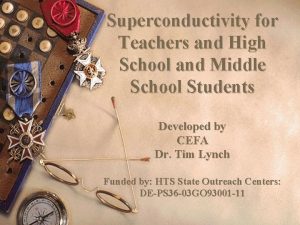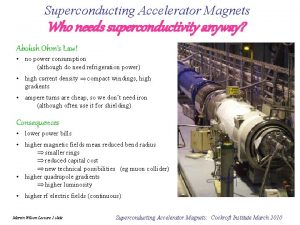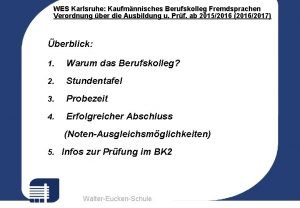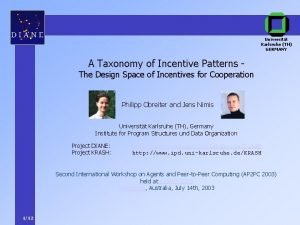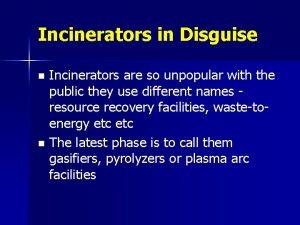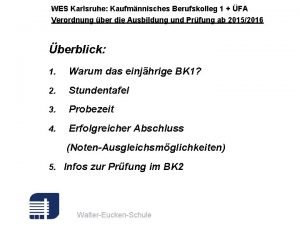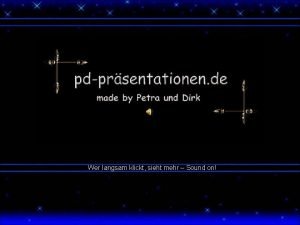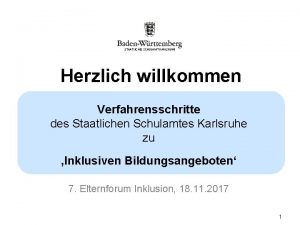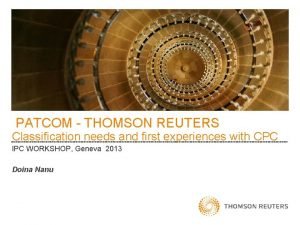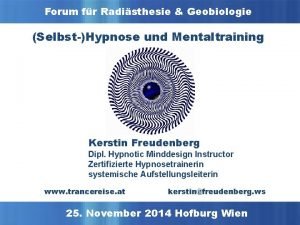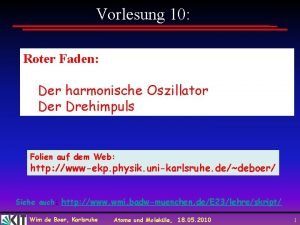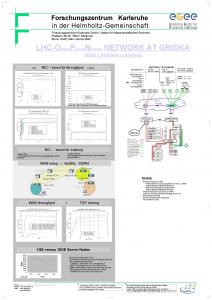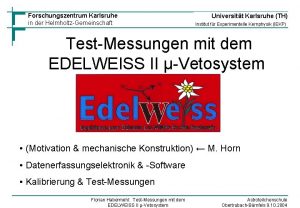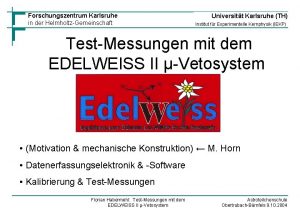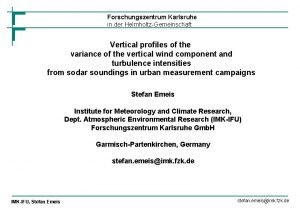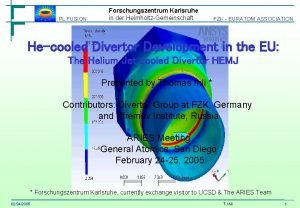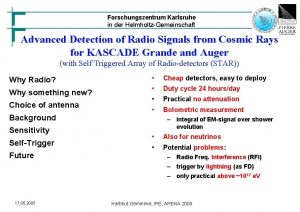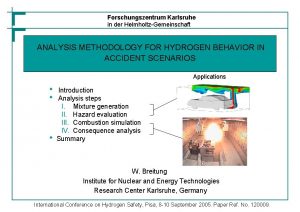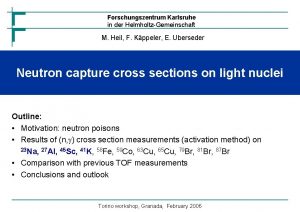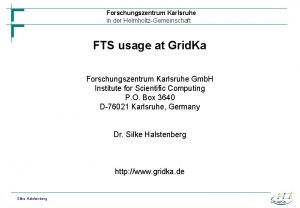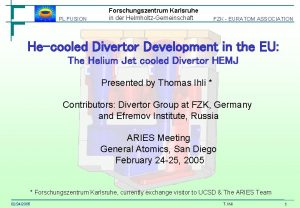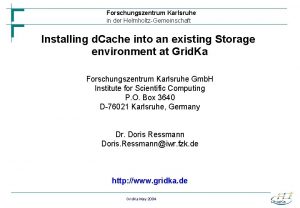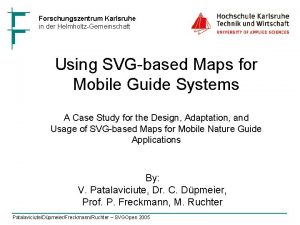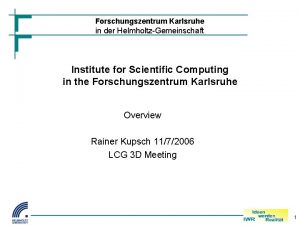Forschungszentrum Karlsruhe in der HelmholtzGemeinschaft High Temperature Superconductors


















- Slides: 18

Forschungszentrum Karlsruhe in der Helmholtz-Gemeinschaft High Temperature Superconductors for Future Fusion Magnet Systems Status, Prospects and Challenges G. Janeschitz, R. Heller, W. H. Fietz, W. Goldacker, G. Kotzyba, R. Lietzow, R. Nast, B. Obst, S. I. Schlachter, C. Schmidt, K. -P. Weiss Forschungszentrum Karlsruhe, Germany IAEA Conference Chengdu 20. October 2006 FZK - EURATOM ASSOCIATION G. Janeschitz et. al. slide # 1

Forschungszentrum Karlsruhe in der Helmholtz-Gemeinschaft Long Term Fusion Magnet R&D ITER ≈ 2016 Demo / Proto Commercial Fusion Power Plant ≈ 2035 ≈ 2050 Need for Efficiency Use of High - Tc Superconductors (HTS) allows Øhigher operating temperatures of 20 K to 77 K Ømuch lower effort for thermal shielding ØHigher thermal stability IAEA Conference Chengdu 20. October 2006 save investment higher efficiency save investment more reliable operation FZK - EURATOM ASSOCIATION G. Janeschitz et. al. slide # 2

Forschungszentrum Karlsruhe in der Helmholtz-Gemeinschaft Efficiency optimization For commercial power plants it is essential to reduce power consumption ITP - refrigerator: ITER: DEMO: 2 k. W@ 4. 4 K = 64 k. W@ 4. 4 K = 0. 7 MW electric power 22 MW electric power ? ? ? MW electric power With a magnet system at 20 K a fusion machine would be more efficient with respect to electric power consumption for cryogenics. Great would be a machine with a superconducting magnet system at 65 K to 77 K! Cooling with liquid nitrogen would be possible! Above 20 K operation will be more reliable due to higher enthalpy IAEA Conference Chengdu 20. October 2006 FZK - EURATOM ASSOCIATION G. Janeschitz et. al. slide # 3

Forschungszentrum Karlsruhe in der Helmholtz-Gemeinschaft Critical Temperature of Superconductors Hg. Ba. Cu. O Tl. Ba. Cu. O Bi. SCCO YBCO Bi. Sr. Ca. Cu. O YBa. Cu. O LN 2 La. Sr. Cu. O La. Ba. Cu. O IAEA Conference Chengdu 20. October 2006 FZK - EURATOM ASSOCIATION G. Janeschitz et. al. slide # 4

Forschungszentrum Karlsruhe in der Helmholtz-Gemeinschaft HTS materials BSCCO and YBCO are promising Boundaries indicate jc = 0 => ultimate boundary Magnets for a Fusionreactor IAEA Conference Chengdu 20. October 2006 FZK - EURATOM ASSOCIATION G. Janeschitz et. al. slide # 5

Forschungszentrum Karlsruhe in der Helmholtz-Gemeinschaft Possible scenarios Taking into account the intrinsic properties of present existing HTS compounds the following scenarios have been identified for fusion devices beyond ITER: 1) 5 K, 12 – 15 T 2) 5 K, Improved Nb 3 Sn CICC ~20 T BSCCO conductor 3) 20 K, 12 – 15 T BSCCO conductor 4) 50 K, 12 – 15 T YBCO coated conductor 5) 65 K, 10 – 12 T YBCO coated conductor IAEA Conference Chengdu 20. October 2006 FZK - EURATOM ASSOCIATION G. Janeschitz et. al. slide # 6

Forschungszentrum Karlsruhe in der Helmholtz-Gemeinschaft Problems of High - Tc Materials • Layered structures • Correct orientation necessary! • S. C. properties depend on doping • Grain boundaries are detrimental • Brittle materials (ceramics) Perfect crystal structure Long time R&D was necessary on the road to High - Tc cables Cu. O 2 - Layers (s. c. ) Spacing Layer Cu. O 2 - Layers (s. c. ) Charge Reservoir / Doping Oxygen doped For example: 90 K Superconductor YBa 2 Cu 3 O 7 Oxygen binds electrons => holes are forming Cooper pairs IAEA Conference Chengdu 20. October 2006 FZK - EURATOM ASSOCIATION G. Janeschitz et. al. slide # 7

Forschungszentrum Karlsruhe in der Helmholtz-Gemeinschaft BSCCO: c - axis orientation is necessary - > rolled tapes c- ax is c - axis This material is industrially available in long lengths. Application: HTS current lead demo for ITER (BSCCO) In the frame of the EU Fusion Development Program, a 70 k. A HTS current lead with Bi - 2223/Ag. Au superconductor was developed and tested in FZK. Current lead consists of three parts: Connection to low Tc S. C. 4. 5 K IAEA Conference Chengdu 20. October 2006 HTS module (Bi - 2223/Ag. Au) 4. 5 K - 65 K Copper heat exchanger 65 K - 300 K FZK - EURATOM ASSOCIATION G. Janeschitz et. al. slide # 8

Forschungszentrum Karlsruhe in der Helmholtz-Gemeinschaft YBCO offers higher B(T) but 3 D orientation necessary c- ax is c - axis Deviation by > 6 degree would already reduce jc significantly Composition of YBCO Coated Conductor (CC) On top a protection layer is placed The YBCO layer adopts the orientation of the buffer layer An oriented buffer layer avoids chemical YBCO / tape reaction A substrate tape is used for deposition YBCO layer thickness ~ 1 The protection layer serves also as a normal conducting shunt when YBCO looses superconductivity (quenches). IAEA Conference Chengdu 20. October 2006 FZK - EURATOM ASSOCIATION G. Janeschitz et. al. slide # 9

Forschungszentrum Karlsruhe in der Helmholtz-Gemeinschaft Status of the YBCO Coated Conductor Basic idea realized in 1996 for short length samples anyhow major difficulties exist: • Homogeneity of long substrates • Buffer layer problem (complicated and time consuming) • Slow growth of YBCO film by sputtering or evaporation However, progress has been achieved by industry: up to 300 m high current coated conductor is available 263 A for a 12 mm wide tape @ 77 K, self field (Super. Power) IAEA Conference Chengdu 20. October 2006 FZK - EURATOM ASSOCIATION G. Janeschitz et. al. slide # 10

Forschungszentrum Karlsruhe in der Helmholtz-Gemeinschaft Potential of HTS for Fusion and Challenges Potential of High Temperature Superconductors • Much higher superconducting transition temperatures up to 105 K • Very high upper critical fields of the order of 100 T • High irreversible (operating) fields at higher temperatures • Excellent critical current densities up to high temperatures & magnetic fields Challenges • Structural reinforcement is required • High conductor (cable) current is necessary for technical application • Hot spot temperature and quench are problematic (current extraction) • Bundling & cabling development to limit AC losses is mandatory The challenges are discussed below. IAEA Conference Chengdu 20. October 2006 FZK - EURATOM ASSOCIATION G. Janeschitz et. al. slide # 11

Forschungszentrum Karlsruhe in der Helmholtz-Gemeinschaft Structural Reinforcement HTS materials are brittle materials and therefore strain sensitive. Therefore a structural reinforcement is necessary. As a consequence the necessary reinforcement reduces the engineering current density. However, • HTS conductors need heat treatment at high temperature in oxygen atmosphere • Embedding of conductor in stainless steel is not possible before heat treatment • React-and-wind technology has to be used which limits the conductor size and the bending radius by the stress-strain behavior The necessary reinforcement technology including react & wind has to be developed. IAEA Conference Chengdu 20. October 2006 FZK - EURATOM ASSOCIATION G. Janeschitz et. al. slide # 12

Forschungszentrum Karlsruhe in der Helmholtz-Gemeinschaft High Conductor (Cable) Current Which minimum conductor current is reasonable? Starting with the parameter of ITER TF coils (N*I = 9. 1 MA, L = 0. 349 H) the discharge voltage and time constant were calculated for different conductor currents Conductor Number of current turns Inductance ratio L/LITER Discharge voltage ( D = 12 s) Discharge time constant (UD = 10 k. V) 68 k. A 134 1 3. 5 k. V 4 s 30 k. A 304 5 17. 5 k. V 21 s 10 k. A 910 45 158 k. V 190 s As a compromise to limit both discharge voltage and time constant, 30 k. A seems to be the minimum acceptable conductor current. 30 k. A made of 40 A tapes (assuming Ic=50 A at 12 T & 50 K) would need 750 tapes! IAEA Conference Chengdu 20. October 2006 FZK - EURATOM ASSOCIATION G. Janeschitz et. al. slide # 13

Forschungszentrum Karlsruhe in der Helmholtz-Gemeinschaft Hotspot Temperature and Quench If the YBCO superconductor quenches the current has to be transferred to the protection layer which has to takes the current until the coil is discharged. Cu YBCO Substrate The maximum temperature reached during quench is called hotspot temperature. The thickness of the Cu layer has to be adopted to limit the maximum temperature. => Depends also on discharge time !! • For a 4 mm wide YBCO-CC with a critical current density of 2000 A/mm 2, and a thickness of the copper stabilizer of 50 m, the hot spot temperature during a discharge ( = 21 s) will be about 120 K. • For a critical current density of 10000 A/mm 2, a copper thickness of 300 m is required to limit the hot spot temperature to 130 K. The increase of the critical current density in the YBCO by a factor of five results in an increase of the overall engineering current density of only a factor of two. => This limits jc, eng! IAEA Conference Chengdu 20. October 2006 FZK - EURATOM ASSOCIATION G. Janeschitz et. al. slide # 14

Forschungszentrum Karlsruhe in der Helmholtz-Gemeinschaft Bundling & cabling development to limit AC losses Cable-in-conduit conductor Nb 3 Sn strand (EM-LMI) Roebel bar conductor concepts already used in Nb. Ti-LCT and NET subsize Applied in BSCCO-cable (SIEMENS) AC-loss optimized TFMC conductor: Multi stage twisted cable-in-conduit with central cooling channel, Rated current: 68 k. A @ 11. 8 T and 4. 6 K AC - loss optimization is one of the most crucial points! IAEA Conference Chengdu 20. October 2006 FZK - EURATOM ASSOCIATION G. Janeschitz et. al. slide # 15

Forschungszentrum Karlsruhe in der Helmholtz-Gemeinschaft Roebel-Assembled-Coated-Conductor (RACC) Design and concept for low AC losses and high transport currents • Mechanical precision punching • Tool optimized for material and thickness • Sequential assembling to RACC structure Result of transport current measurements: 12 mm IAEA Conference Chengdu 20. October 2006 Ic = 1020 A @ 77 K, self field (1 μV/cm) Result agrees well with expectations for a cable with 16 tapes. FZK - EURATOM ASSOCIATION G. Janeschitz et. al. slide # 16

Forschungszentrum Karlsruhe in der Helmholtz-Gemeinschaft Conclusions HTS allows higher temperatures and fields compared to classical superconductors However, today a high current HTS conductor for 30 k. A is a real challenge with following critical items: • High current conductor layout Conductor layout has to consider structure reinforcement and react&wind technology. Main limitation is the large number of tapes which have to be used for cabling. • Hotspot temperature and quench The copper stabilizer has to be large to limit the hot spot temperature which limits the engineering current density. • Bundling & cabling development to limit AC losses Innovative cabling techniques have to be developed to limit AC losses. A first 1 k. A class Roebel type (RACC) cable was successfully fabricated by FZK from commercially YBCO coated conductor. • The achieved critical current agreed well with expectations. • The technique is reliable, suitable for long lengths & scalable for large currents. IAEA Conference Chengdu 20. October 2006 FZK - EURATOM ASSOCIATION G. Janeschitz et. al. slide # 17

Forschungszentrum Karlsruhe in der Helmholtz-Gemeinschaft Outlook HTS R&D has to be adopted to fusion needs. Goal should be a ~ 30 k. A cable at 50 K / 12 T for future Fusion reactors. Main targets are: • • Improvement of bundling and cabling techniques • • Fusion conductor development in collaboration with industry • • Design, manufacturing and test of a HTS Model–Solenoid • • Design, manufacturing and test of a TF HTS Demonstration Coil in collaboration with industry Acknowledgment This work, partly supported by the European Communities under the contract of Association between EURATOM and Forschungszentrum Karlsruhe, was carried out within the framework of the European Fusion Development Agreement. The views and opinions expressed herein do not necessarily reflect those of the European Commission. IAEA Conference Chengdu 20. October 2006 FZK - EURATOM ASSOCIATION G. Janeschitz et. al. slide # 18
 Haus der wirtschaft karlsruhe
Haus der wirtschaft karlsruhe Surge current protection using superconductors
Surge current protection using superconductors Types of superconductors
Types of superconductors Persistent currents
Persistent currents Surge current protection using superconductors
Surge current protection using superconductors What are superconductors
What are superconductors Superconductors
Superconductors Difference between curie temperature and neel temperature
Difference between curie temperature and neel temperature Difference between curie temperature and neel temperature
Difference between curie temperature and neel temperature Difference between curie temperature and neel temperature
Difference between curie temperature and neel temperature Kaufmännisches berufskolleg karlsruhe
Kaufmännisches berufskolleg karlsruhe Incentive karlsruhe
Incentive karlsruhe Thermoselect karlsruhe
Thermoselect karlsruhe Bk2 probezeit nicht bestanden
Bk2 probezeit nicht bestanden Karlsruhe schiff
Karlsruhe schiff Staatliches schulamt karlsruhe
Staatliches schulamt karlsruhe Christiane emmerich fiz karlsruhe
Christiane emmerich fiz karlsruhe Karlsruhe geobiologie
Karlsruhe geobiologie 18 harmonien karlsruhe
18 harmonien karlsruhe
